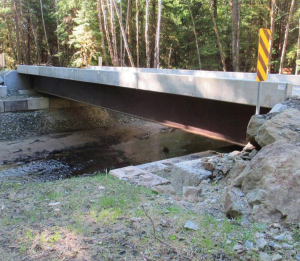Washington agencies recently honored many of the state’s largest private forest landowners – including several Washington Forest Protection Association members – for their efforts to improve fish habitat.
During the August Forest Practices Board meeting and in a joint news release, Washington State’s Department of Natural Resources (DNR), Department of Ecology (DOE) and Department of Fish and Wildlife (WDFW) applauded working forests for completing their Road Maintenance and Abandonment Plan (RMAP) before the October 2021 deadline. The state agencies noted that private forest landowners are particularly deserving of the special recognition for “leaning into” improving fish habitat – especially during the Great Recession in the late 2000s.
Said Jeff Davis, WDFW director of conservation and a Forest Practices Board member:
“One thing becomes really crystal clear is that we have a lot of amazing public land management partners. We have the Tribal nations doing great conservation work. But none of it would amount to meaningful differences without the private landowners participating in conservation actions…We can’t express enough how much appreciation we have for the private landowners who stepped up even in bad economic times and got the work done, and we all benefit from that.”
Since 2001, private forest landowners have worked in collaboration with DNR, WDFW, DOE, and the Tribes to support salmon recovery efforts and clean water, applying science and best practices to guide forest practices through the Forests & Fish Law. And well-maintained roads are an important part of the Forests & Fish agreement.

As an integral component of the landmark Forests & Fish Law, RMAP was developed to improve water quality and habitat for fish and other aquatic species. Through the RMAP process, forest roads are upgraded to meet forest current practices rule standards. RMAP prioritized road removal or repair on a worst-first basis with consideration for the greatest benefit to fish.
Said Hilary Franz, Commissioner of Public Lands:
“This is a great moment for us to really honor the unbelievable work that’s happened by so many across the state with a true commitment to not only managing our forests better but also taking care of the critical salmon and the fish and wildlife habitat that depend on these resources. This is a significant moment of success that we should all sit back and just be really proud of the work that has been happening. The improvements made through RMAPs represents one of the greatest successes in the Washington forest practices arena over the last 20 years.”
To date, the RMAP and work done under the Forests & Fish Law has resulted in:
- 31,000 miles of forest roads improved to meet contemporary forest practice standards
- 4,000 miles of unused roads safely abandoned
- 8,500 miles fish passage barriers removed or corrected to nearly 53,000 miles of fish habitat
Said Jason Spadaro, WFPA executive director:
“A very common theme among forest landowners is the pride in our lands and the stewardship that we employ on our lands. The Forests and Fish Habitat Conservation Plan is quite literally the most successful model of landscape conservation and success in the state of Washington, if not the country. We’re very proud to be part of it. We’re very proud of the partnership that we have with our Timber/Fish/Wildlife partners and we’re very proud of our accomplishments and leading the way in Washington.”
Indeed, the RMAP and Forests & Fish is a testament of what can happen when people dedicated to protecting the state’s natural resources – including promoting healthy, resilient forests – work together toward mutually beneficial outcomes. Many agency representatives lauded the completion of RMAP by the state’s largest private forest landowners as an example for future private-public endeavors.
Among the large private forest landowners recognized are current and former WFPA members:
